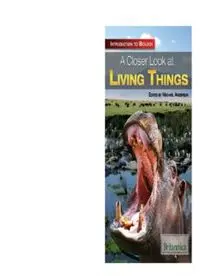
A Closer Look at Living Things (Introduction to Biology) PDF
Preview A Closer Look at Living Things (Introduction to Biology)
Published in 2012 by Britannica Educational Publishing (a trademark of Encyclopædia Britannica, Inc.) in association with Rosen Educational Services, LLC 29 East 21st Street, New York, NY 10010. Copyright © 2012 Encyclopædia Britannica, Inc. Britannica, Encyclopædia Britannica, and the Thistle logo are registered trademarks of Encyclopædia Britannica, Inc. All rights reserved. Rosen Educational Services materials copyright © 2012 Rosen Educational Services, LLC. All rights reserved. Distributed exclusively by Rosen Educational Services. For a listing of additional Britannica Educational Publishing titles, call toll free (800) 237-9932. First Edition Britannica Educational Publishing Michael I. Levy: Executive Editor, Encyclopædia Britannica J.E. Luebering: Director, Core Reference Group, Encyclopædia Britannica Adam Augustyn: Assistant Manager, Encyclopædia Britannica Anthony L. Green: Editor, Compton’s by Britannica Michael Anderson: Senior Editor, Compton’s by Britannica Sherman Hollar: Associate Editor, Compton’s by Britannica Marilyn L. Barton: Senior Coordinator, Production Control Steven Bosco: Director, Editorial Technologies Lisa S. Braucher: Senior Producer and Data Editor Yvette Charboneau: Senior Copy Editor Kathy Nakamura: Manager, Media Acquisition Rosen Educational Services Jeanne Nagle: Senior Editor Nelson Sá: Art Director Cindy Reiman: Photography Manager Karen Huang: Photo Researcher Matthew Cauli: Designer, Cover Design Introduction by Jeanne Nagle Library of Congress Cataloging-in-Publication Data A closer look at living things / edited by Michael Anderson. p. cm.—(The Environment: Ours to Save) “In association with Britannica Educational Publishing, Rosen Educational Services.” Includes bibliographical references and index. ISBN 978-1-61530-583-4 (eBook) 1. Organisms—Juvenile literature. 2. Life (Biology)—Juvenile literature. I. Anderson, Michael, 1972- QH309.2.C564 2012 578—dc22 2011011720 On the cover: A hippopotamus, a huge mammal that lives in eastern Africa, is seen against the back- drop of Ngorongoro Crater, a nature reserve in East Africa. Shutterstock.com Interior background images Shutterstock.com CONTENTS IntroductIon 6 chapter 1 the characterIstIcs of LIvIng thIngs 10 chapter 2 ceLLs, tIssues, and organs 21 chapter 3 nutrItIon and energy productIon 37 chapter 4 evoLutIon and the hIstory of LIfe on earth 45 chapter 5 the cLassIfIcatIon of LIvIng thIngs 58 concLusIon 75 gLossary 76 for More InforMatIon 79 BIBLIography 82 Index 83 he world is flled with living and nonliving things. In most cases, fg- Turing out which of them are alive is easy. For instance, it’s obvious that a fuzzy woodland creature scampering across a feld is alive, while a rock plunked down in the middle of that same feld is not. Science, however, doesn’t leave such things to casual observation. In order for an organism to be alive, it must pass a series of seven tests. One test concerns movement. Living things are able to get from one location to another, or they at least have movement within themselves. For an example of the second type of movement, consider a tree. It can’t move from one place to another, but it does have the ability to move water, nutrients, and other materials internally. Whatever the type of motion, it must occur under the organism’s own power. Being pushed, pulled, or otherwise forced to move doesn’t count. A second test is sensitivity. Living organisms respond to conditions in their environment using whatever senses they have. Plants stretch and grow toward sun- light. Animals and people finch when they hear a loud sound or feel a sharp touch. 6 INTRODUCTION The ability to gather nutrients (the source of energy) from food sources is another test that proves something is alive. Eating other organisms is how most animals, including humans, obtain energy. Plants make their own food through a chemical process known as photosynthesis. Some food energy is used right away, while some is stored for later use. The process used to create energy from food is another essential characteristic of living things. It’s called respiration. In most cases, respiration involves the exchange of oxygen and carbon dioxide, a process that releases energy. Humans and land animals inhale oxygen and exhale carbon dioxide from the air using lungs. Fish and many other aquatic animals don’t have lungs but are able to absorb oxygen and expel carbon dioxide through structures called gills. Plants absorb and push out gases through stomata, or pores, in their leaves. Living things grow, meaning new cells are added on to or replace old cells that make up an organism’s body. Examples of growth include legs or stems getting longer, teeth sprouting through the gums of youngsters, and new layers of skin or wood that cover and heal wounds. In a few special cases, plants 7 A Closer look At living things Scientists have discovered nearly 2 million diferent species, or kinds, of living things. Most of these species are animals. About half of all spe- cies are the animals known as insects. Encyclopædia Britannica, Inc. and animals can replace a body part that has been lost—a tail, for example—through a process called regeneration. A living organism also has to be able to cre- ate more of its kind through reproduction. 8 introduCtion Living things reproduce either sexually, with two parents, or asexually, where an organism creates new life on its own. The fnal test that every living thing must pass is the ability to get rid of waste and toxic substances through excretion. These unwanted and potentially harmful materials are produced in plants, animals, and humans in the process of living. Plants release waste gases into the air through their stomata. Animals and humans sweep waste and toxins out of their bodies primarily through sweat, urine, and feces. The ability to do just one or a few of the functions listed here is all well and good, but that doesn’t mean that something is alive. All seven characteristics must be present for an organism to be considered a true living thing. 9
